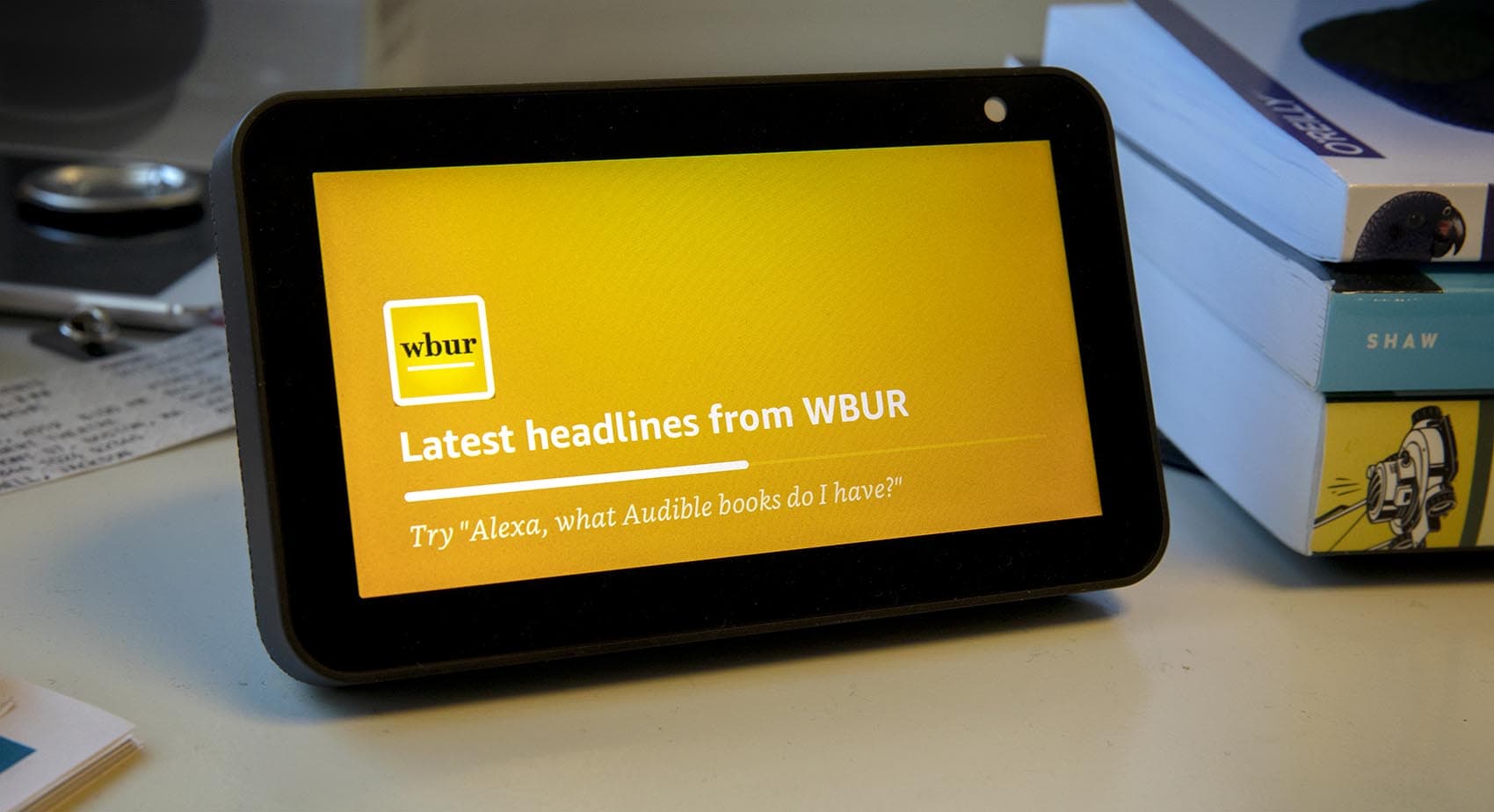Advertisement
How Public Radio Can Reach People On Smart Displays

While public media organizations and other news outlets are grappling with how to approach smart speakers, there's yet another new piece of voice-enabled hardware to keep up with: those speakers that also have screens, aka the smart display.
These devices — like Amazon's Echo Show and Google's Nest Hub — do exactly what you would expect; they pair all the capabilities of a smart speaker with a digital touchscreen. They're also becoming more popular.
Project CITRUS has several smart displays, including an Echo Show 5, which has been perched on my desk for a few weeks now. The more I used it, the more curious I got about how news outlets can reach smart-display users.
Degrees Of Difficulty
Whereas voice interactivity is the sole focus with screenless smart speakers, smart displays bring a multimodal user experience involving images, text, video, etc., into the fold. The Alexa flash briefing is one use case where some innovation is taking place within public media when it comes to news on smart displays — namely from NPR and its "visual newscast" (which, it should be noted, is not exclusive to Amazon devices, nor exclusively available as a flash briefing).
So if you're a news outlet looking have a presence on smart displays, what are your options? Here's one attempt at a breakdown.
The Baseline
An Alexa flash briefing is by far the simplest way to get a toehold in the smart-speaker world. It also provides an opportunity — albeit an extremely limited one — to add a dash of visual bling. So if you have a flash briefing, double-check that your feed icon looks good on a smaller screen, and add any pertinent Text content or Display URL values.
WBUR's flash briefing is a repurposing of our hourly newscast (as many flash briefings are across the public radio universe). We haven't yet customized our smart-display presentation beyond the off-the-shelf Amazon options.
A Bit More Effort
A small step up from that stock decor could entail taking over the flash-briefing screen with a custom GIF or static image. NPR does this for the majority of its 24 hourly newscasts — only a fraction of which are accompanied by a bespoke video when the flash briefing plays. Instead, the user is given a moving illustration of a kitchen scene (complete with a succulent and boiling kettle).
Few, if any, public media outlets besides NPR are doing this, making it a (relatively) low-hanging differentiator. It also has the added appeal of not necessitating extensive staffing or daily production upkeep.
A Lot Of Effort
This tier entails creating video content based on pre-existing broadcast material. The aforementioned NPR "visual newscast" — a custom, labor- and resource-intensive product predicated upon the hourly radio newscast — is one example.
Stations could theoretically emulate this strategy by pairing their local newscast with a visual accompaniment, which would then become the flash briefing. There's also potential to take a single-topic story — as opposed to the multitopic newscast — and create a short visual package based on that one story. (We've done some experimenting with that latter approach.)
The Most Effort
Here, we're talking about making smart display-first content (though certainly not smart display-only content). This means creating original video independent of any broadcast workflows or material — an incredibly steep investment.
I couldn't find any examples of this approach within public media, which is unsurprising. The smart-display audience remains extremely niche, for one thing, and many member stations — WBUR included — lack the kind of resources and bandwidth to justify making such a tiny audience a major priority.
Dedicated Smart-Display Strategy Upsides ...
- The obvious: Simply a better experience for smart-display users. Instead of using the standard-issue visuals, a strategic approach could yield new, unique, and/or improved content that is more appealing to the user.
- Meeting people where they are: The number of smart device with screen owners is growing, and content offerings should mature accordingly.
- Repurposing content: Share the visual content made for smart displays on social media, upload it to YouTube, embed it in web stories, etc.
- The ability to make use of extra images and video clips that might otherwise land on the cutting room floor.
- It's an opportunity for innovation and brand boosting that aligns with WBUR's mission to be a multiplatform news source.
... And The Downsides
- It takes serious time and dedicated staffing, especially if the goal is producing daily content.
- What's the ultimate value add? Sure, it will enhance the smart-display experience and drive some engagement elsewhere (web and social, for instance). But the potential upside on such a nascent platform is, at best, murky.
- One of the primary upsides of a voice-activated device is how it can enhance multitasking. A user can cook dinner while simultaneously pulling up a weather report, for example. But are people going to stop what they're doing and actually watch this content? Or will they drift in and out while prepping the vegetables? Or will they just listen to it? (NPR product manager Joseph Price shared some insight on this aspect of the display experience.)
- Outside of simply getting the content created, can it be compelling enough to maintain a consistent audience over the long term if/when its novelty wears off?
- Video predicated on still images significantly stretches the in-house photo library, especially if you're a station with few or no digital resources. Most WBUR audio stories lack sufficient visual coverage for even a minute-long video. And, let's face it, it's not exactly the most compelling form of video.
- Building out a robust video strategy can cost big money, from staff photographers (WBUR has two!), to supplemental wire-service subscriptions like AP Images or Storyful, to marketing and promotion.
Advertisement
Postscript: What About Google?
Amazon in many respects remains the default when it comes to voice hardware. A recent survey we conducted found 73% of WBUR listeners who own a smart speaker own an Amazon device, whereas 28% own a Google device.
Amazon has also differentiated itself from Google via the user-customizable flash briefing, for which publishers can design or repurpose a shortform video package.
While Google's voice infrastructure lacks a flash briefing-type feature, accessing video news content is still pretty straightforward. A simple, "Hey Google, what's in the news?" on a device like a Nest Hub initiates a playlist of news videos from national and international outlets like Reuters, CNN and Bloomberg (clipped or repurposed from TV broadcasts and web video content). In addition, a swipe left on the device's home screen brings up a Google News tab, which a user can tap through to begin playing video news coverage of "Top stories" from, again, the likes of CNN, The Washington Post and other publishers.
It's worth noting that this coverage is overwhelmingly nonlocal.
In short, while prioritizing Amazon's display ecosystem feels more pressing at this stage, we will certainly be paying attention to how both Amazon and Google create a place for local news video on their respective hardware — and pushing for its inclusion.
Some Questions Moving Forward
- To what extent will local video news coverage have a seat at the table within news sections and "carousels" on Amazon and Google smart displays?
- Under what circumstances would local stories appear in, for example, the Nest Hub's "Top stories" tab? What kind of relationship needs to exist between Google and a publisher to make that happen, whether editorially or technically, or both?
- Going even deeper, would Google ever geolocate, say, Boston smart-display users and serve up WBUR video content to them when they're asking for news or tapping around in search of it on their display?
